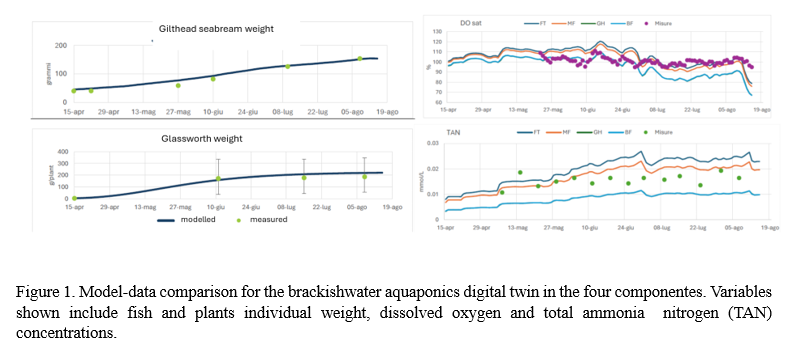DEVELOPING AND TESTING A DIGITAL TWIN FOR A BRACKISHWATER AQUAPONIC FARM
Aquaponics is an innovative food production technique, deriving from the integration of recirculating aquaculture system (RAS) and hydroponics, suitable for development of urban and peri-urban food productions1,2. However, high CAPEX/OPEX of aquaponics require a careful selection of highly remunerative products in order to achieve economic sustainability. Aquaponics practiced in brackishwater conditions seems to offer interesting options for sectorial diversification.
The present work, performed in the framework of the Interreg Italy-Slovenia project BEBLUE, aims at studying the functioning of a pilot aquaponic farm rearing gilthead seabream (Sparus aurata), in combination with macroalgae (Ulva rigida) and samphire (Salicornia europea). The approach was based on the precision fish farming framework3, combining monitoring efforts with the development of a digital twin of the aquaponic farm. The digital twin is a dynamic mathematical model describing the evolution of the aquaponic system, through the simulation of: 1) the key metabolic processes of fish, primary producers and bacteria; 2) the water balance and the transport process of the suspended solids and the dissolved metabolites; 3) the chemical equilibria regulating solution acidity. The model includes four typical components of an aquaponics system, namely: 1) Fish Tank (FT); 2) Mechanical Filter (MF); Biofilter (BF) amd GreenHouse.
The model was tested by comparing its outputs with the experimental data gathered by monitoring the pilot system over a 4 months period, between April 15th and August 15th 2024. Model results (Figure 1) successfully reproduced the observed seabream and samphire individual weight and total biomass, as well as the concentration of the abiotica variables: Dissolved Oxygen and Total Ammonia Nitrogen are shown in Fig. 1. Simulated and observed nitrate concentration, not shown, presented in increasing trend, highlighting that the cultivated crop surface could assimilate only a small fraction of the N metabolized by the fish. This output can be of interest for system design, supporting a correct dimensioning. Observed fluctuations in oxygen concentration were reproduced satisfactorily, showing a slightly lower O2 concentration in the biofilter, although compensated by an adequate reaeration rate. Also in this case, the model could be of help for dimensioning the air insufflation systems and producing early warning of oxygen drifts. The three variables defining the carbonate system, total alkalinity, DIC, and pH, are correctly represented, with a slight underestimation of pH during the initial phase of the simulation. The capability of simulating the carbonate system dynamics is useful for an informed optimization of pH conditions which are contextually adequate for the biofilter and the crops.
Modelling and monitoring results were discussed, to derive a set of recommendations for the development of aquaponics in brackish water.
References
1. Lennard, W. & Goddek, S. Aquaponics: The Basics. in Aquaponics Food Production Systems (eds. Goddek, S., Joyce, A., Kotzen, B. & Burnell, G. M.) 113–143 (Springer International Publishing, Cham, 2019). doi:10.1007/978-3-030-15943-6_5.
2. Elnour, M., Haller, H. & Martin, M. Life cycle assessment of a retail store aquaponic system in a cold-weather region. Front. Sustain. 3, 1051091 (2023).
3. Fore M., Frank K., Norton T., Svendsen E., Alfredsen J.O., Dempster T., Eguiraun H., Watson W., Stahl A., Sunde L.M., Schellewald C., Skoien K.R., Alver M.O., Berckmans D., 2018. Precision fish farming: a new framework to improve production in aquaculture. Biosyst Eng 173:176–193. https:// doi. org/ 10. 1016/j. biosy stems eng. 2017. 10. 014
